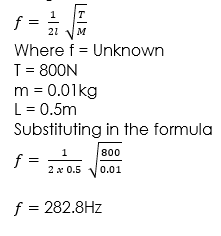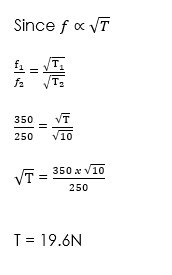Back to: PHYSICS SS2
Welcome to class!
In today’s class, we will be talking about musical instruments. Enjoy the class!
Musical Instruments

Musical instruments are designed to produce pleasant, soothing or enjoyable sound. We can classify them into:
(1) Wind instruments
(2) String instruments
(3) Percussion Instruments
Wind instruments
Wind instruments are used in the production of musical notes. These instruments produced sound by the vibration of the air column in a tube. Stationary and longitudinal waves are produced in this process. Examples include:
- Flutes
- Pipe organ
- Trumpet
- Trombone
- Clarinet
- Saxophone
- Horn etc.
String instruments
String instruments are essentially made of tightening wire or length of the gut which when struck, produces transverse wave which is transmitted to both ends that are fixed to a stationary wave which vibrates in a single segment. Examples include:
- Guitar, which contains six strings performing various functions.
- Piano, containing various numbers of strings of varying length, i.e. minor, major.
- Sonometer
- Violin
- Harp
WORKED EXAMPLES
(1) A piano wire 0.5m long has a total mass of 0.01kg and is stretched with a tension of 800N. Calculate the frequency of the wire when it sounds its fundamental note.
SOLUTION
using

(2) A sonometer wire of length 100cm under a tension of 10N, has a frequency of 250 Hz keeping the length of the wire constant, the tension is adjusted to produce a new frequency of 350 Hz. What is the new tension?
SOLUTION
Suppose T is the required new tension

String instruments
The application of forced vibration is employed in percussion instruments. These are instruments which produce sound when they are struck or hit. Thus, progressive and longitudinal sound waves are produced in the surrounding air. Examples include:
- Drum
- Bell
- Gong
- Xylophones
- Tambourine
- Turning fork
- Talking drum etc.
Percussion instruments are of different sizes. For instance, there are different sizes of drums with different sounds. Some are big while some are small. The sound produced depends on the size of the drum and the degree of their lightness.
SOUND ABSORPTION
Concert halls or large lecture rooms or broadcasting studios need to have a special acoustic (sound) design. If not, the sound is reflected from walls, ceiling or floors and this can disturb the sound from an orchestra or a speaker which reaches the audience.
To absorb the sound from the surface, suitable tiles of plastic or cork or other porous materials are used to cover the walls and other surfaces in concert halls or studios. In a large lecture room, cushions are often placed at the back of chairs.
ECHO
When a sound wave travelling encounters a hard surface such as walls, rock etc, it is reflected. Thus, when a sound is produced in a large empty hall or near a cliff, the sound is heard over and over again. That is, the sound ‘repeats’ itself over a short time. This is called ‘echo’. It is due to the reflection of the sound waves from the walls of a hall or the cliff. In large concert halls and broadcast studios, echo tends to interfere with the original voice of the speaker making it difficult to hear the speaker clearly. Echo is, therefore, a nuisance in these situations. To reduce this problem, materials which do not reflect sounds (sound-absorbent materials) such as curtains, foam and double glazed windows are used on the walls.
The ceiling is also made of sound-absorbing slates, perforated pads to reduce reflection and enhance absorption of sound waves.
It must be noted however that echo is not totally a nuisance in sound recording.
Application of Echo
(i) Approximate determination of the speed of sound:
If sound travels from source, S to the reflecting surface, R, and the echo is heard again at the source after a time interval t. then we can say, total distance travelled = 2d. Speed of sound therefore is given by:
V = 2d/f
This principle may be used to measure the approximate speed of sound in air. Sound is directed towards a reflecting surface by clapping two wooden boards together and the time taken to hear the echo is recorded with a stopwatch.
(ii) Echo Sounding
This is used to measure the depth of the seabed. The instrument is called sonar and used in ships to know when the ship is approaching the shore. The principle is similar to the one explained above. The sound pulse is sent out by transmitter are directed towards the seabed. The sound is reflected from the seabed and detected by the receiver. The time (t) taken for the echo to be received is recorded. Since the velocity sound in seawater is known, the depth of the seabed can be calculated from the formulae:
V = 2d/f d = v * t/2
Echo sounding is also used for locating shoals of fish and shipwrecks.
(iii) Mineral Exploration
Geophysicists used the principle of echo sounding in prospecting for mineral deposits in the earth. Analysis of reflected or refracted sound waves sent in to the earth (seismic waves) can reveal a lot of features and properties of the earth. This is then used to determine the presence and quality of crude or mineral deposits.
(iv) Radar System
RADAR is an acronym for Radio Detection and Raging. Is used in aviation to detect and measures the location and distance or aircraft. Waves sent out from the source are reflected by the aircraft and receives back at the source3. Analysis of the reflected signal can give the location, direction and speed of an approaching aircraft.
WORKED EXAMPLES
(1) A bat emits sound wave at a speed of 15m/s and receives the echoes 0.5s later. Calculate the distance of the bat from the reflector.
SOLUTION

(2) A boy standing 95m from the front of a tall cliff his hands and hears an echo 0.6s later. Calculate the speed of the sound in air.
SOLUTION

Reflection of sound
When sound waves strike a surface, they return back into the same medium. This phenomenon is called reflection.
We hope you enjoyed the class.
Should you have any further question, feel free to ask in the comment section below and trust us to respond as soon as possible.

Wow so interesting
I really enjoy your lecture. Thanks so much.
More wisdom and divine enablement in Jesus Christ name.
You guys are really doing great work.